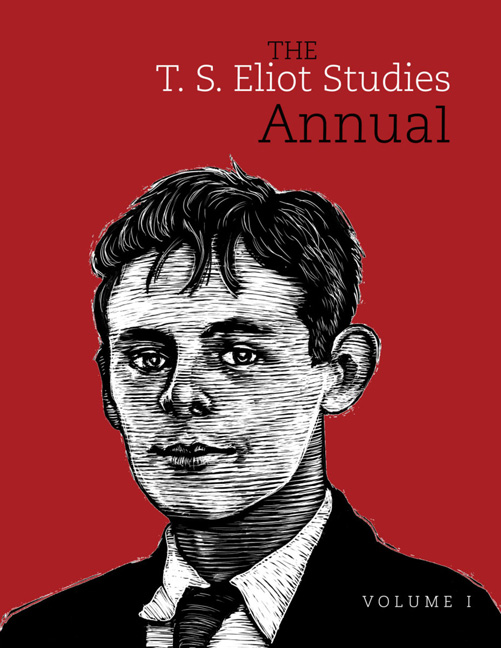Book contents
- Frontmatter
- Contents
- Abbreviations of Works
- General Editor's Note
- The Short and Surprisingly Private Life of King Bolo: Eliot's Bawdy Poems and Their Audiences
- Dull Tom-Tom's Absurd Prelude: Ludic Modernism in Early T. S. Eliot
- Eliot at Bergson's Lectures, 1910–1911
- The American Legacy of “Prufrock”
- Poetry (June 1915)
- The Stale Dregs of Revolt
- Prufrock, Belated
- Eliot's Allusive Legacy and Obscurity in “Prufrock”
- Transmuting F. H. Bradley: T. S. Eliot's Notes Towards a Theory of Poetry
- T. S. Eliot, Phenomenologist
- Astride the Dark Horse: T. S. Eliot and the Lloyds Bank Intelligence Department
- Aristophanic Structures in Sweeney Agonistes, “The Hollow Men,” and Murder in the Cathedral
- Eliot and Virgil in Love and War
- T. S. Eliot Bibliography 2014
- Notes on Contributors
Aristophanic Structures in Sweeney Agonistes, “The Hollow Men,” and Murder in the Cathedral
- Frontmatter
- Contents
- Abbreviations of Works
- General Editor's Note
- The Short and Surprisingly Private Life of King Bolo: Eliot's Bawdy Poems and Their Audiences
- Dull Tom-Tom's Absurd Prelude: Ludic Modernism in Early T. S. Eliot
- Eliot at Bergson's Lectures, 1910–1911
- The American Legacy of “Prufrock”
- Poetry (June 1915)
- The Stale Dregs of Revolt
- Prufrock, Belated
- Eliot's Allusive Legacy and Obscurity in “Prufrock”
- Transmuting F. H. Bradley: T. S. Eliot's Notes Towards a Theory of Poetry
- T. S. Eliot, Phenomenologist
- Astride the Dark Horse: T. S. Eliot and the Lloyds Bank Intelligence Department
- Aristophanic Structures in Sweeney Agonistes, “The Hollow Men,” and Murder in the Cathedral
- Eliot and Virgil in Love and War
- T. S. Eliot Bibliography 2014
- Notes on Contributors
Summary
T. S. Eliot subtitled Sweeney Agonistes, his first foray into drama, as “Fragments of an Aristophanic Melodrama.” The nature of this descriptor has been occasionally explored, although more often with reference to Eliot's five-page outline of the projected play (referred to as “The Superior Landlord” manuscript) than in relation to the technical material that may have informed his composition. For instance, examining the extant text of Sweeney Agonistes in light of Attic Old Comedy suggests that Doris, and not Sweeney, is the protagonist of the fragmentary play.
Yet, Eliot's deep interest in Aristophanic structures has implications for works other than Sweeney Agonistes. Two fragments, “Eyes that I last saw in tears” and “The wind sprang up,” were published together with what became “The Hollow Men” III under the collective title “Doris's Dream Songs” in 1924. Even at this late stage, Sweeney Agonistes and “The Hollow Men” may not have been wholly distinct, and Aristophanic elements, such as antichoria (the division of the chorus into halves, performing antiphonally), seem to remain in “The Hollow Men” as a residue of the two works’ unified origin.
Additionally, by his own admission, Eliot was a tentative dramatist when he began his first complete play, Murder in the Cathedral. He returned to a ritual structure, that of Aristophanes, when he composed the play. E. Martin Browne, commenting on an early draft of Murder in the Cathedral, states that “[i]t will be noticed that there appear two historical characters, Herbert of Bosham and John, Dean of Salisbury. … They clearly have been sacrificed to the formal pattern.” What this formal pattern constituted Browne does not state. I hypothesize that it is the ritual structure of the Aristophanic play adapted to the religious pageant play. This ritual structure may not only explain some of the play's more elusive features such as the sermon or the knight's defense but also reveal hidden thematic resonances.
Eliot was deeply engaged with Attic Old Comedy at the time when he wrote Sweeney Agonistes and “The Hollow Men.” One of the first apparent references to Sweeney Agonistes is in a 1923 letter to Ezra Pound, wherein Eliot comments cryptically, “Have mapt out Aristophanic comedy, but must devote study to phallic songs, also agons.”
- Type
- Chapter
- Information
- The T. S. Eliot Studies Annual , pp. 157 - 176Publisher: Liverpool University PressPrint publication year: 2017



